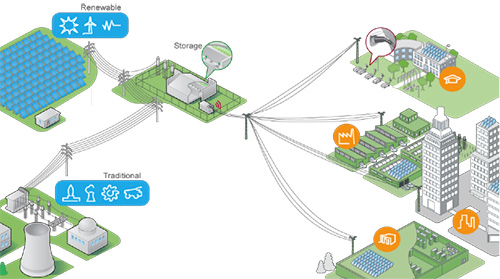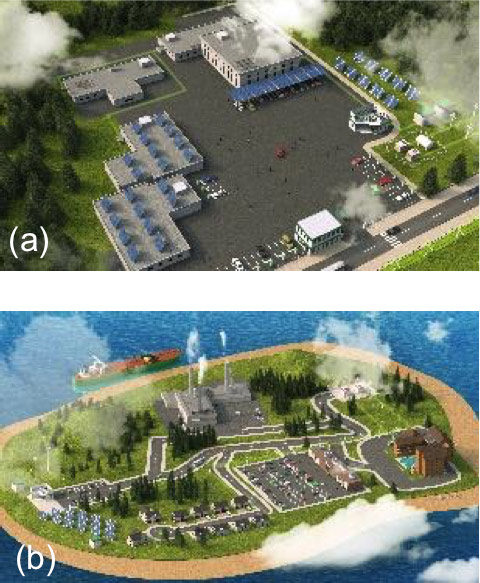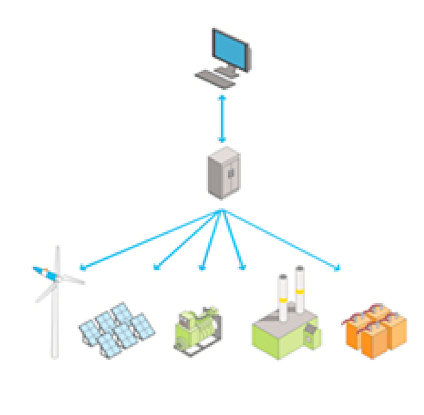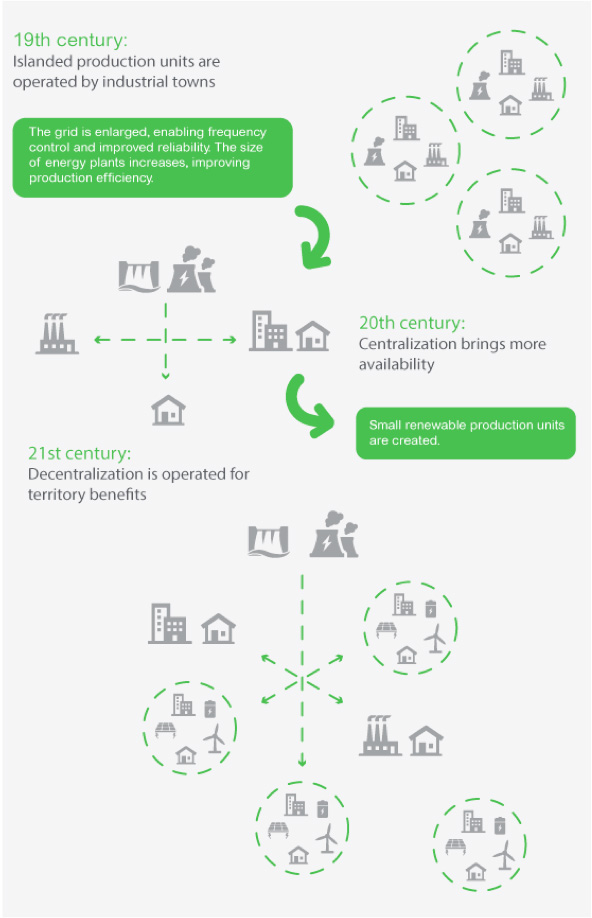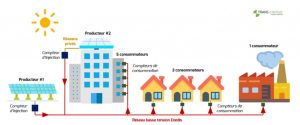Microgrids are the emerging energy ecosystems that provide practical answers to tackle the energy transition challenges of the 21st century. The following paper describes what are the energy transition key issues and how microgrids benefits can answer these challenges. This paper is extracted with courtesy of Schneider Electric from a series of Schneider Electric white papers on the microgrid topic.
Microgrids enable an optimized way to access reliable, green, and resilient energy through a local, interconnected energy system within clearly defined electrical boundaries, which incorporate loads, decentralized energy resources, battery storage, and control capabilities. Let’s see in more detail what a microgrid is and what benefits it delivers.
1. What is a microgrid?
A microgrid is a local, interconnected energy system within clearly defined electrical boundaries that:
- incorporates loads and decentralized energy resources, including storage,
- multiple energy sources or electrical-only,
- grid-connected or off-grid mode,
- a single entity with its own independent control in both modes,
- power range from several kW to multiple MW, voltage range up to MV.
In the early 20th century, the centralization of electricity production made huge progress, enabling significant economies of scale and improved power plant efficiency. The 21th century is encountering new challenges that decentralized solutions such as microgrids could help to tackle. These new challenges are described here after within “The energy transition context” section.
2.The energy transition context
The energy transition encompasses many challenges which are described below. The first one will be a growth of the worldwide energy demand.
2.1. Expected increase of global electrical energy demand
According to the International Energy Agency (IEA) the world’s electrical energy demand is expected to increase by approximately 40% by 2030 (compared to 2012[1]), considering the reduction of consumption resulting from energy efficiency efforts. Of course, the short- term evolution might vary according to economic conditions and regions. However, the global trend is driven by significant factors such as:
- demographics: 18% growth by 2030, mostly in developing countries, ultimately reaching 7.1 billion people[2],
- access to energy for developing countries,
- the ever-growing number of new electrical appliances,
- the expected move of some energy usage toward electricity (for example, electric vehicles),
- the growing global urbanization that shifts where additional energy is needed and the necessary expansion of grid infrastructure.
Energy demand is growing and the paradox is that CO2 emissions must decrease.
2.2. CO2 emissions and fossil energy reduction
CO2 emissions from electricity generation account for 45% of world energy-related emissions. Carbon emissions from electricity generation depend on both the quantity of electricity produced and the generation mix (or types of sources used)[3]. The quantity of electricity is directly related to demand for energy, which is expected to increase globally. Therefore, reducing the amount of CO2 emitted would require a change to the energy mix in favor of “cleaner” sources. Moreover, in isolated areas, inhabitants rely primarily on diesel generators and spend a considerable amount of money importing fuels making renewable generation a cost-effective alternative.
Moreover, electricity reliability is a key expectation from all of us.
2.3. Need for resiliency
In some developed countries, the power grid is aging and has little resilience in the face of disruption or instability, especially those presented by severe weather. The number of power outages lasting more than an hour has increased steadily for the past decade. This is particularly problematic in the U.S.[4] [5] where, according to the U.S. Department of Energy, blackouts cost American businesses more than $100 billion per year, with weather-related disruptions costing the most per event. A main cause of the increasing number of blackouts associated with weather events is aging infrastructure: In the last five years, 68 to 73 percent of all major outages were due to weather and their impact is expected to increase in the future. Even if most interruptions in energy supply are created by local events, the impacts often lead to national or international issues.
Need of resiliency is a key expectation but access to energy is a basic human right.
2.4. Access to energy for 1.2 billion people
An estimated 17% of the global population–around 1.2 billion people did not have access to electricity in 2013 due to the lack of, or inadequate, infrastructure. In addition, many more people have an energy supply that is unreliable or of poor quality. The bulk of those living without electricity (95%) are in sub-Saharan Africa and developing Asian countries, predominantly in rural areas. Access to modern energy may be a crucial factor to achieving several United Nations Millennium Development Goals, enabling the poor in developing countries to engage in the productive use of energy, and thereby leading to an improvement in their living conditions[6].
Decentralization could help tackle these energy challenges of the 21st century by creating an optimized way to access reliable, green, and resilient energy.
3. The microgrid concept
3.1. Microgrids and energy trends
Energy industry predictions include an increase in electrical energy demand, improved access to energy globally, and the reduction of CO2 emissions and fossil fuel energy. These, as well as the need for increased resiliency, are driving a new energy ecosystem: microgrids. These are local and independent energy supply systems, usually based upon multiple energy sources.
Therefore, microgrids could be one of the keystones for the energy transition.
3.2. The emergence of new energy system
Decentralization is one major development that could help address the energy challenges of the 21st century. In the early 20th century, the centralization of electricity production made significant progress, enabling economies of scale and improved plant efficiency. Twentieth-century centralization also increased the overall use of electrical power. Today, however, the situation has evolved considerably and utilities need to provide more and cleaner energy to a larger number of people, with high resiliency.
Major technical and economic changes have also occurred–the energy market has changed dramatically in the last 10 years alone. There has been substantial progress in decentralizing energy resources, such as solar energy and battery storage systems. The IoT (Internet of Things) is operational, driving new cooperation and optimization capabilities. These factors enable the emergence of new energy ecosystems such as microgrids, which offer a way to tackle our energy challenges.
While this paper primarily focuses on microgrids for electrical energy systems, microgrids can also include other primary energy systems – such as fuel oil, natural gas, hot water, and steam, if allowed by local circumstances and regulations.
4. Microgrid benefits
Microgrids contribute to the energy transition by providing practical and accessible answers to improve energy reliability, resiliency, energy accessibility, energy independence, green energy safety, energy cost optimization, energy flexibility, and the ability to participate in demand response or grid-balancing programs.
4.1. Energy reliability
Energy resiliency can be achieved through the microgrid’s ability to island itself from the main grid and to be self-sufficient.
When the main grid encounters disruption or instability, the microgrid is quickly decoupled and continues to deliver energy from local energy sources. With the microgrid’s local management system, load priorities and control strategies may be optimally managed and adjusted. In addition, when the risk of instability is predictable (such as when severe weather is forecasted), the microgrid can be prepared by intentionally adopting a precautionary strategy (like reducing non-critical loads and charging the battery storage) to increase the future resilience of the system. If one of the distributed energy resources (DER) experiences a problem or undergoes maintenance, the microgrid enables the possibility of back-up using autonomous and dynamic reconfiguration.
4.2. Energy cost optimization and energy flexibility
Energy cost optimization can be achieved through the capability of the microgrid control system to use the best mix of resources such as energy storage, demand- response programs, or grid-balancing services.
To enable self-consumption of green energy, local renewable sources can be used to displace all or part of the energy consumed from the main grid or local fossil fuel generators–helping reduce energy-related greenhouse gas emissions. Adding local energy storage can help further maximize the use of this resource by storing the renewable energy during the daylight (solar), and consuming the stored power at night when solar is not operating.
Secondly, it is possible to use microgrids as a flexible, distributed energy asset. For example, the microgrid can participate in demand response or grid balancing by optimizing the local generation, energy storage, and load management schedules to comply with a curtailment or ancillary services request–while taking customer constraints and utility tariff rates into consideration.
4.3. Energy independence and green energy
Microgrid control enable to integrate affordable renewable energy, boost safety, reduce CO2 emissions, and lower fuel costs.
In many cases, a nation’s energy needs are met by importing petroleum to satisfy demand. The diesel fuel used for electricity generation creates substantial CO2 emissions and a high dependency on fuel imports that impact local economies. For example, in the islands of Tonga, about 97% of total generation currently comes from diesel gensets. That represented about 12 megaliters (3.2 million gallons) of fuel in 2012. Only the remaining 3% of generation comes from PV. Microgrid technology can drastically improve situations like this by providing smart power and energy management capabilities that enable a higher penetration of renewables, which until recently were limited by stability and variability problems. – See the pilot project REIDS « Renewable Energy Integration Development Singapore » [7].
4.4. Energy accessibility
Energy access is a human right. Microgrids enable access to energy at a reasonable cost, when in a remote area or far from the main grid, through the microgrid’s self-sufficiency.
Microgrids could drastically accelerate deployment of smart grids to remote areas and increase access to energy in developing countries. Smart grid implementation is complex and calls for considerable adaptation of grid infrastructure, which will take time. Microgrids are a near-term alternative to demonstrate the potential of smart, distributed energy systems now. In developing countries that lack an energy network, decentralization of local renewable sources could be inspired by the expansion of mobile telephony, which can overcome the obstacle of investment in communications infrastructure. Similarly, in the short term, basic microgrids can provide pragmatic solutions for producing and delivering energy.
5. Conclusion
Energy decentralization is a major development that could help tackle the energy challenges of the 21st century. Major technical and economic changes continue to occur. There is substantial progress regarding decentralized energy resources, such as solar energy and battery storage. IoT is also operational–driving new cooperation and optimization capabilities. Microgrids are one answer to this energy transition situation and their benefits encompass energy reliability, energy accessibility, independence through renewable generation, and energy cost optimization.
Microgrids’ future is difficult to predict at this stage, but it seems possible that we are moving into an era where microgrids will be the norm and not the exception. Prospective studies show that this future is technically feasible and could be a way to introduce widespread adoption of intermittent generation such as solar or wind[8]. Microgrids could be one of the keystones for energy transition[9].
Notes et références
[1] Forecast of electricity production and use, International Energy Agency
[2] The Impact of Electricity Access on Economic Development: A Literature Review’, Productive Use of Energy (PRODUSE)
[3] Carbon emissions from electricity generation for the top ten producers (2012)’, International Energy Agency
[4] The Smart Grid: An Introduction’, U.S. Department of Energy
[5] ‘Think Microgrid, a Discussion Guide for Policymakers, Regulators and End Users,’ International District Energy Association, Schneider Electric, Microgrid Knowledge
[6] The Impact of Electricity Access on Economic Development: A Literature Review’, Productive Use of Energy (PRODUSE)
[7] REIDS pilot project, https://www.youtube.com/watch?v=fyokZRVWRmc
http://www.smartgrids-cre.fr/index.php?p=microgrids-reids
[8] Vincent Krakowski, Xiang Li, Vincent Mazauric, Nadia Maïzi, (2016). “Power system synchronism in planning exercises: From Kuramoto lattice model to kinetic energy aggregation”, The 8th International Conference on Applied Energy – ICAE2016
[9] White paper series from Schneider Electric: How Microgrids Contribute to the Energy Transition http://download.schneider-electric.com/files?p_Doc_Ref=9982095_12-01-16A_EN
L’Encyclopédie de l’Énergie est publiée par l’Association des Encyclopédies de l’Environnement et de l’Énergie (www.a3e.fr), contractuellement liée à l’université Grenoble Alpes et à Grenoble INP, et parrainée par l’Académie des sciences.
Pour citer cet article, merci de mentionner le nom de l’auteur, le titre de l’article et son URL sur le site de l’Encyclopédie de l’Énergie.
Les articles de l’Encyclopédie de l’Énergie sont mis à disposition selon les termes de la licenceCreative Commons Attribution– Pas d’Utilisation Commerciale – Pas de Modification 4.0 International.


